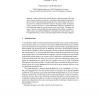Free Online Productivity Tools
i2Speak
i2Symbol
i2OCR
iTex2Img
iWeb2Print
iWeb2Shot
i2Type
iPdf2Split
iPdf2Merge
i2Bopomofo
i2Arabic
i2Style
i2Image
i2PDF
iLatex2Rtf
Sci2ools
UM
2005
Springer
2005
Springer
Motion-Based Adaptation of Information Services for Mobile Users
Adaptive information systems typically exploit knowledge about the user’s interests, preferences, goals etc. to determine what should be presented to the user and how this presentation should take place. When dealing with mobile users, however, information about their motions—the places visited, the duration of stays, average velocity etc.—can be additionally exploited to enrich the user model and better adapt the system behavior to the user’s needs. This paper discusses what type of positioning data and background knowledge is required to achieve such a motion-based adaptation of information provision and how it can be implemented using a variety of mostly standard machine-learning techniques.
| Added | 28 Jun 2010 |
| Updated | 28 Jun 2010 |
| Type | Conference |
| Year | 2005 |
| Where | UM |
| Authors | Mathias Bauer, Matthieu Deru |
Comments (0)

